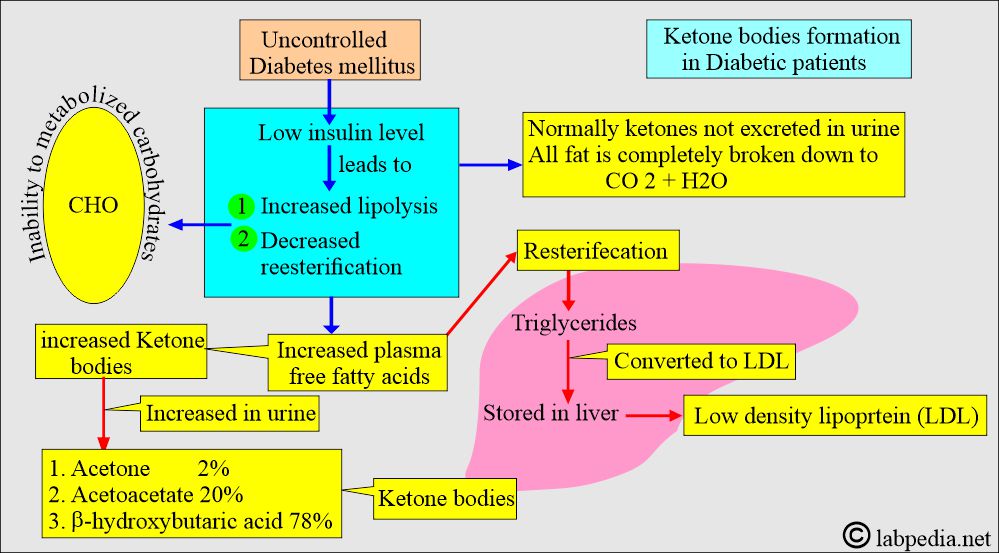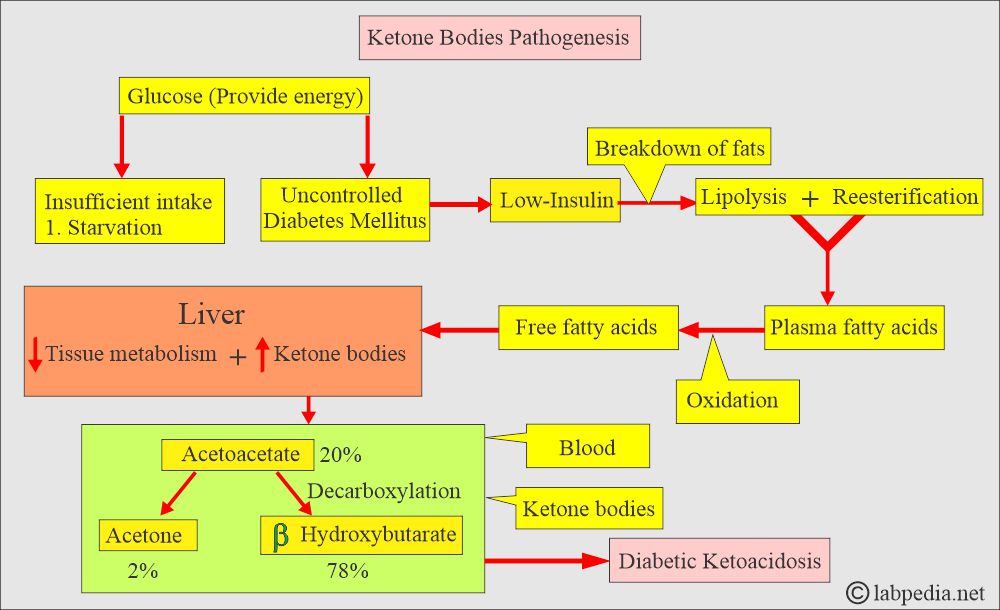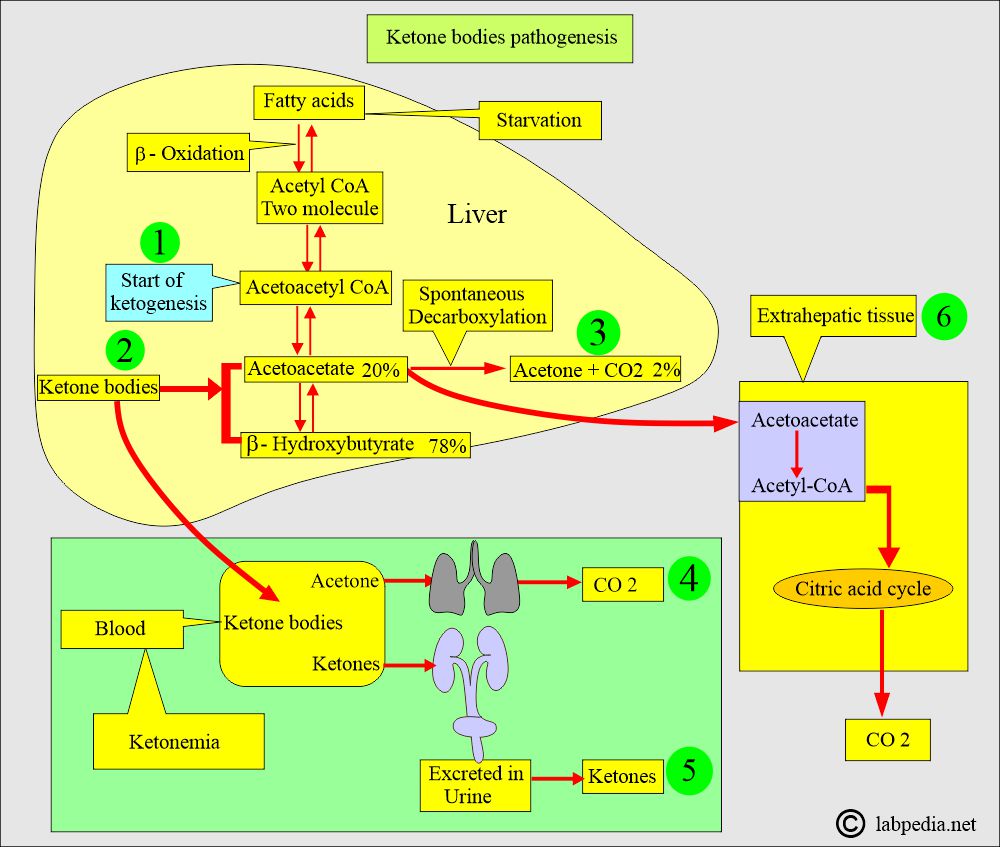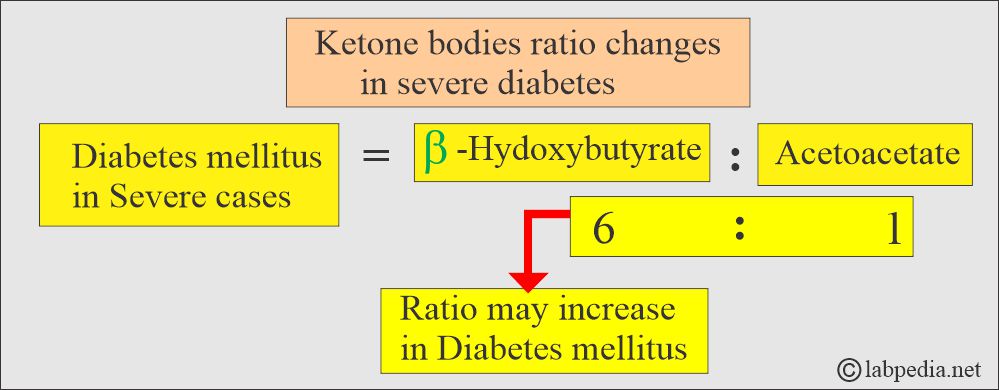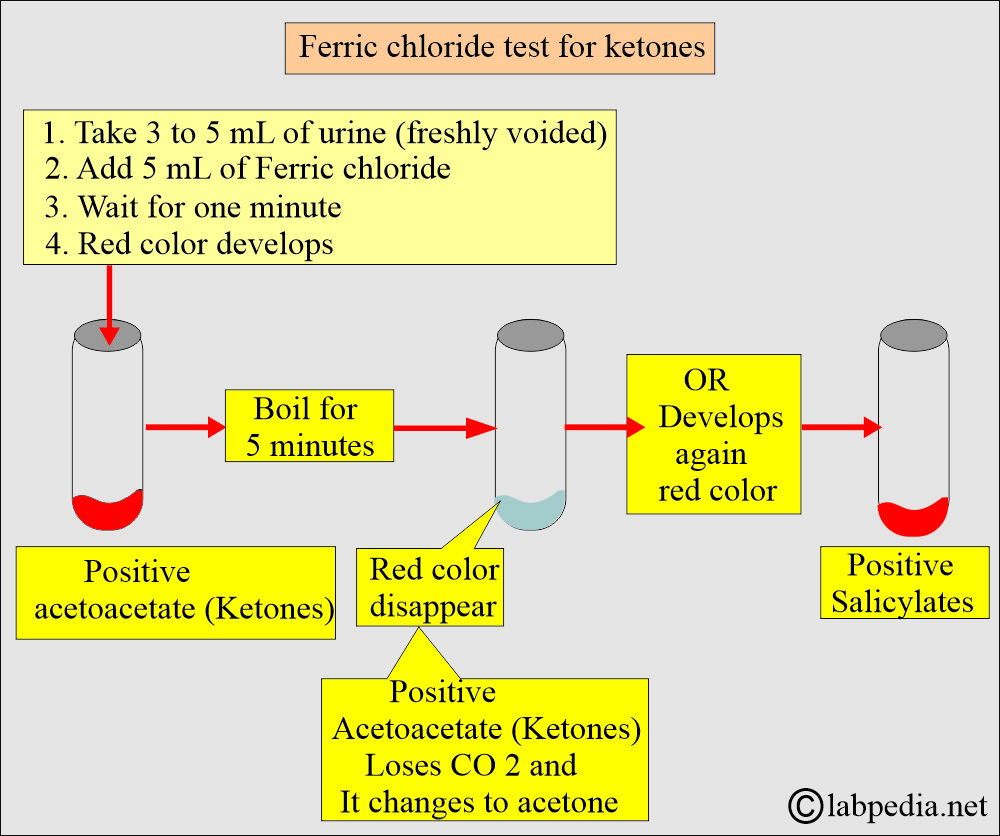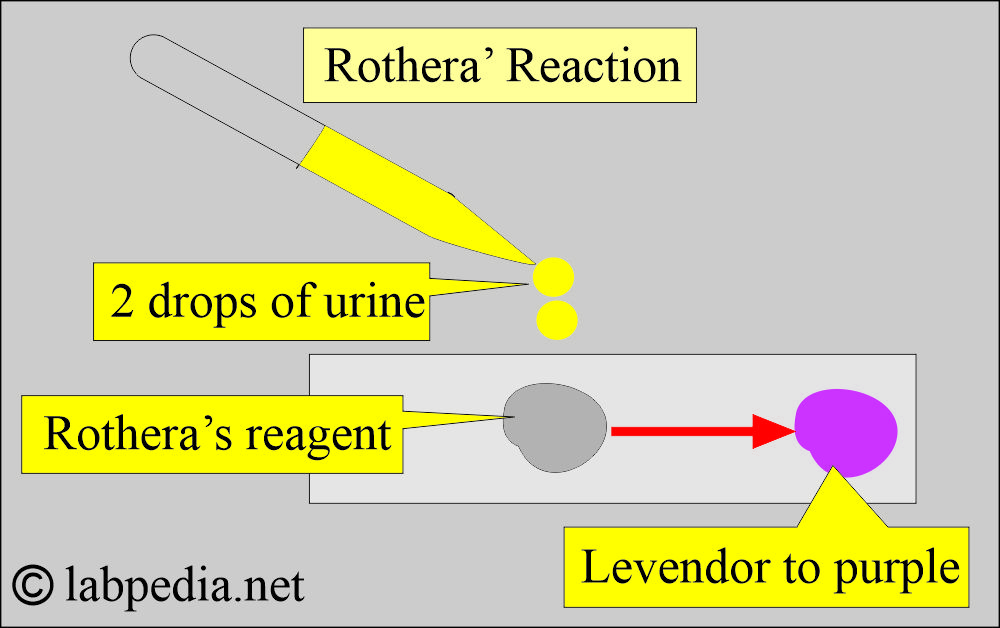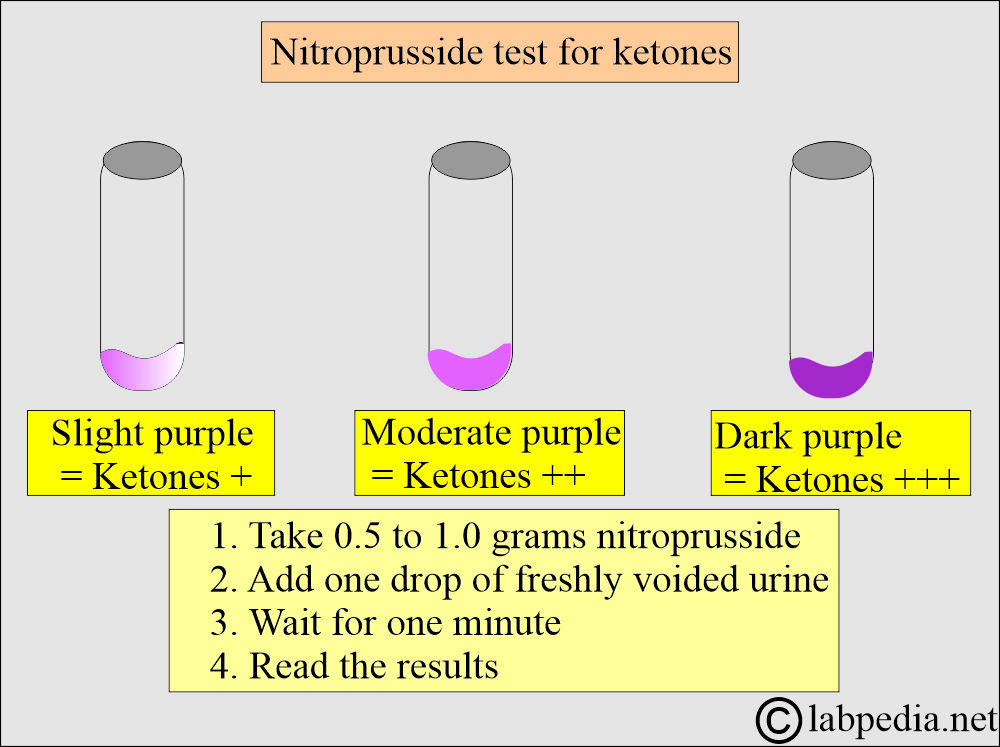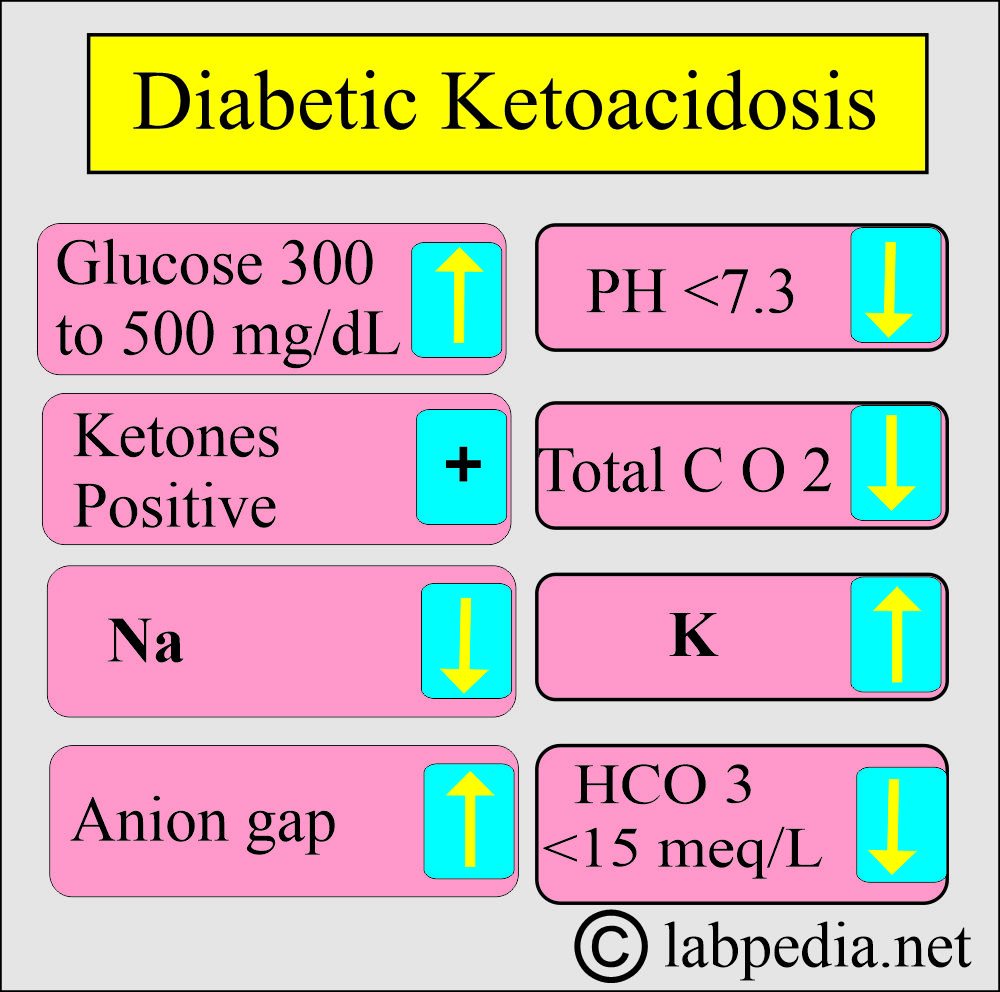Diabetes Mellitus:- Part 7 – Diabetic Ketoacidosis and Ketone Bodies
Diabetic Ketoacidosis
What sample is needed for Diabetic Ketoacidosis?
- The ketones can be detected in blood and urine.
What are the precautions for Diabetic Ketoacidosis?
- False-positive tests may occur with certain medications.
- Prolonged exposure of the strips to air gives a false-negative result.
How will you define diabetic ketoacidosis?
- This is an acute life-threatening metabolic acidosis due to uncontrolled diabetes mellitus.
- It is primarily due to type 1 diabetes, and less frequently to type 2 diabetes.
- It is a decompensated stage of intercurrent illness and severe insulin deficiency.
- There is excess hormone-producing glucose.
- Normally, no ketones are present in the urine.
- Diabetic ketoacidosis is characterized by the presence of Ketone bodies in the blood and urine.
- There is a presence of ketones in the blood, which are toxic acids.
How will you discuss the pathophysiology of Diabetic Ketoacidosis?
- This is a complication in diabetic patients with hyperglycemia and massive fatty catabolism.
- The primary substrate for ketone body formation is free fatty acids from adipose tissue.
- This is due to the lack of insulin in uncontrolled diabetes mellitus.
- These free fatty acids are substrates for the formation of ketone bodies.
- When reesterified in the liver, these free fatty acids are converted into triglycerides and low-density lipoproteins.
- When the body cannot utilize carbohydrates or glucose, it cannot enter the cells.
What is the mechanism of ketone body production?
- Glucose provides energy to the body. During starvation or uncontrolled diabetes mellitus, the energy is supplied by the breakdown of fats.
- In the blood samples, mainly 78% is beta-hydroxybutyric acid, and acetone is hardly 2%.
- Ketones are formed when fats are used as energy by the body. The enzymes responsible for forming ketone bodies are present in the mitochondria.
- Acetyl-CoA from acetoacetyl-CoA by the β-oxidation.
- Acetoacetyl-CoA- CoA is the starting point of ketogenesis.
- Acetoacetate is formed from the acetoacetyl-CoA in the liver.
- In the extrahepatic tissue, acetoacetate is activated by acetoacetyl-CoA.
- Now, acetoacetyl-CoA- CoA is split into acetyl-CoA by thiolase, is oxidized in the citric acid cycle, and produces CO2.
- In most cases of ketonemia, increased ketone bodies are formed in the liver and are not dependent upon the utilization of ketone bodies in the extrahepatic tissue.
What are the Ketone bodies?
- Acetoacetate.
- β-hydroxybutyrate.
- Acetones.
- Ketone bodies are the end product of fatty acid breakdown.
- The presence of ketone bodies in the urine indicates poorly controlled diabetes mellitus.
How will you define Ketonemia and ketonuria?
- It is called ketosis when the body can not utilize the ketone bodies produced in excess.
- These are excreted in the urine and are called ketonuria. There is the excretion of ketones in more than trace amounts.
- The elevated level of ketones in the blood is referred to as ketonemia.
- This overproduction of ketone acids leads to acidosis or a lowering of blood pH.
- Ketone bodies are toxic to the brain; if present in abundance in the blood, they will lead to coma.
- Diabetic ketoacidosis is a life-threatening metabolic acidosis due to uncontrolled diabetes mellitus, usually seen in type 1 and less commonly in type 2.
What are the Signs and Symptoms of diabetic ketoacidosis?
- This condition is typically associated with carbohydrate deficiency, starvation, or frequent vomiting.
- The patient will have a thirst and a dry mouth.
- Increased frequency of urine.
- There is easy fatigue.
- There may be nausea, vomiting, and abdominal pain.
- There is a fruity odor on the breath.
- Difficulty in concentration and confusion.
- This condition can become grave if not treated promptly.
- Ultimately, the patient may go into a coma.
How will you detect the ketone bodies?
Gerhardt’s ferric chloride:
- It reacts with acetoacetate only.
- Principle of Gerhardt’s test:
- The reagent is a 10% ferric chloride solution.
- It is based on the reaction of ferric chloride (FeCl3) with acetoacetic acid, which produces a characteristic red color.
How will you perform Gerhardt’s test?
- Take 3 to 5 mL of urine.
- Add 5 mL of Ferric chloride solution.
- Note the color; if it is red, it indicates the presence of ketone bodies, specifically acetoacetic acid.
- Now boil the above solution for 5 minutes.
- Color disappears, indicating acetoacetic acid. By boiling, acetoacetic acid changes to acetone by losing CO2.
- The color remains red, indicating the presence of salicylates.
What do you know about the Nitroprusside Method for ketone?
- It is 10 times more sensitive to acetoacetate than acetone.
How will you perform the Strip method with Nitroprusside?
- Take a urine (freshly voided sample).
- Add sodium nitroprusside (strips) = Deep violet color in positive cases.
- It has no reaction to β-hydroxybutyrate.
How will you perform Rothera’s test?
- It is the modification of the Nitroprusside method.
How will you perform the Nitroprusside tube method?
- Add 0.5 to 1.0 grams of nitroprusside to the bottom of the test tube, or place it on a porcelain tile.
- Add one drop of freshly voided urine. Sufficient to moisten the powder.
- Observe for one minute for the development of a mauve-purple color.
- It is easy to assess the color when testing in a test tube. It is visible more clearly against a white background.
How will you report the Nitroprusside test results?
| Color change of the reagent | Test result for ketones |
|
|
|
|
|
|
|
|
- For β-hydroxybutyrate, urine is heated to convert β-hydroxybutyrate to acetone and acetoacetate by oxidation.
- Commercial kits are available to estimate the β-hydroxybutyrate.
- Ketone bodies in the urine:
- The urine ketone bodies test detects acetoacetate and acetone, which are ketone bodies.
What are the findings in diabetic ketoacidosis?
| Lab test | Result |
|
|
|
|
|
|
|
|
|
|
|
|
|
|
|
|
|
|
|
|
|
|
|
|
|
|
What are the complications of diabetic ketoacidosis?
- There is brain edema due to fluid accumulation.
- The patient may have a cardiac arrest.
- The patient may go into kidney failure.
How will you treat diabetic ketoacidosis?
- Start with saline for volume replacement.
- Insulin infusion (but delay if serum potassium level is low <3.3 meq/L.
- Potassium replacement when the serum level is <5.5 meq/L.
- Glucose drip (5% dextrose with 0.45% saline when the plasma glucose level is <250 mg/dL).
- Continue glucose and insulin until the anion gap is <12 meq/L.
Questions and answers:
Question 1: What is Gerhardt's test?
Question 2: What are complications of diabetic ketoacidosis?
Question 3: What ketone bodies are detected in the urine?

